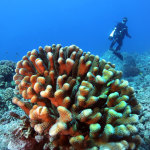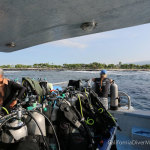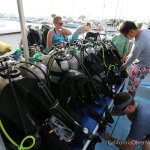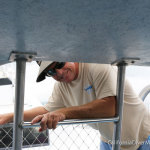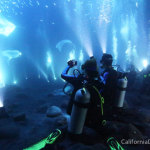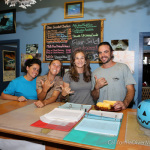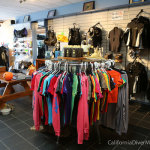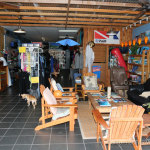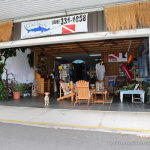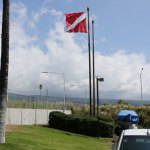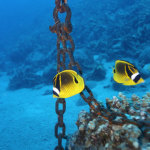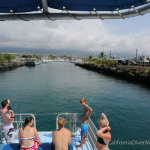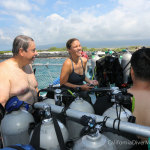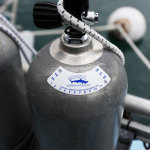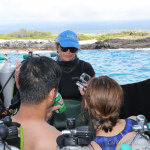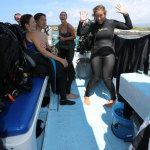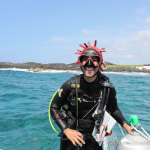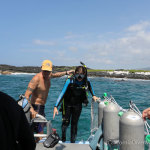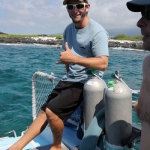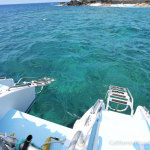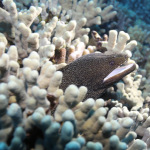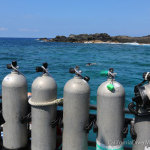[vimeo clip_id=110683056]
The Hawaiian Islands are home to a few dozen dive shops, most offering the standard fare of air fills, dive equipment, lessons, and charter boat trips. Some specialize in technical diving or wreck diving; others cater to smaller groups and 6-pack charters. There’s even one on Maui who fuels their boat with biodiesel to help provide a more environmentally-friendly dive experience.
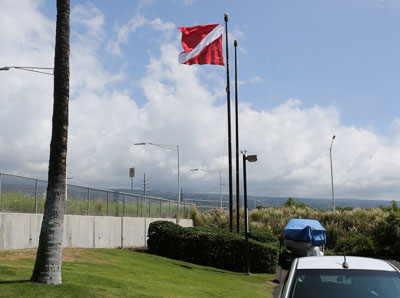
Look for the large dive flag and you’re at Kona Diving Company
On Hawaii’s Big Island, a large dive flag flies high on a pole above Queen Ka’ahumanu Highway in Kailua-Kona – you’ll see it on your way into town from the airport. At its base lies one of Hawaii’s more unique and likely friendliest dive shops: Kona Diving Company. What makes this shop most unique is not a huge retail space or fleet of charter boats. Simply put, it’s their people, and the truly exceptional experience they provide.
Kona Diving Company is a relative newcomer to the diving scene here. The shop opened in 2010 after owners Simon and Kerry Key purchased Bottom Time Hawaii, changed locations, and reopened with a new name, a fresh start, and a new mission. The business officially started January 1st, 2010, however it took a few more months to find the location, build out the shop, and open for business.
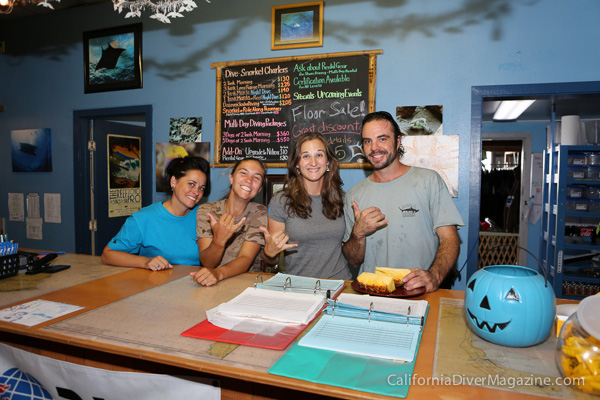
Above: Kona Diving Company’s Stephany Hayes, Katie Key, Hailey Hawkins, and Ryan Wilson
Kerry explains: “I made a bet in May with a local guy who lived in town. The bet was we would be open for business, in this new shop, July 1st. He looked around the shop and he’s like, “There’s no way you can pull that off, you can’t do it.” We made the bet, and I was determined to win and open by July”.
Kerry and her eager team did what they set out to do, opening for business on the morning of July 1st. Their new shop was equipped with a full retail store, a huge inventory of rental equipment, instruction (intro courses through Instructor), and an 18-passenger charter boat – a catamaran named “Hale Kai”. Having the physical structure in place, Kerry and the team were finally able to create a unique experience for divers in their own style, which began with hiring the right staff to work at their new shop and on the dive boat.
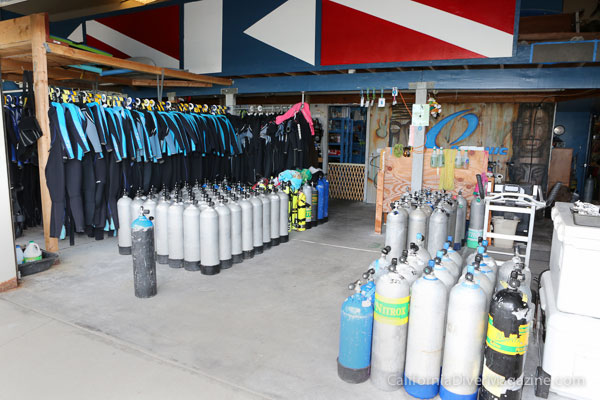
Kona Diving Company’s rental gear. They’re very well equipped to fully gear large and small groups, and just about any diver.
“From Day one, everyone knew that there was passion here”, employee Stephany Hayes shared. “Word of mouth just spread about the people here. This is what set us apart, even from the beginning – the crew members, the instructors, the dive masters, the boat captains – they all love the ocean. They’re excited about little tiny animals and giant…anything! And they’re deeply passionate about it. The passion spills over because they want to share it – they’re genuinely excited to share it with you. If you say to them, “I really want to see this” they’ll say, “Let’s try to find that.” You’re not just coming out to go diving and you see what you see on your own.”
Hailey Hawkins chimed in. “Every snorkeling/diving company knew that Kerry and Katie had something really, really special to share. You were going to be lucky to get on their boat and go out with them, and the word got out. I think that’s the key ingredient – there’s something really special going on here.”
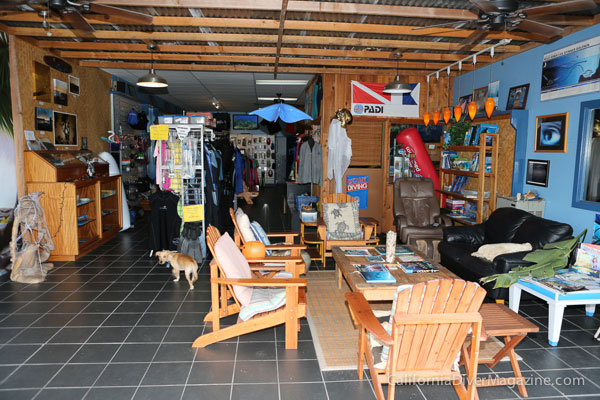
A welcoming lounge area greets you at the entrance to Kona Diving Company.
Finding a stable crew of passionate employees isn’t easy, but keeping them on board once hired is one thing that hasn’t been to be a challenge. The employees are much more than just coworkers; they spend their days off together (often diving, of course), and they even have their own dive shop band. “We spend our holidays at their house. We celebrate our birthdays together. Half of our crew is in a band that practices upstairs.”
There is no tension and drama here. And they all know their stuff (and then some) about both diving and life under the sea.
“Not very many places can you go into a shop and say, “Can you tell me the life cycle of this butterfly fish?” and have not only one but five people say, “Here’s what it is” and tell you all about it. The crew here are excited about things that I never even knew existed before working here. Excited about them – I mean really excited about them!”
This passion extends throughout Kona Diving Company and onto their dive boat trips as well, of course. At many dive shops you can call a few hours (or even days) before your trip and find out exactly where you’ll be diving. At Kona Diving Company, you’ll likely get a different answer when you ask this question.
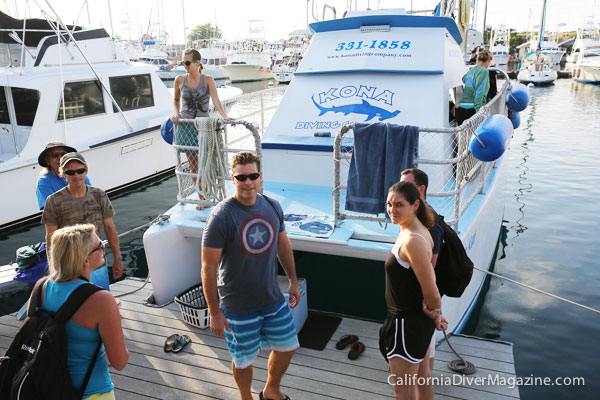
California Diver Editor Kevin Kay and fellow divers gather for our pre-boarding meeting before boarding the Hale Kai.
Kerry explains. “When we check someone in we’ll say, “What do you want to see? What excites you? Do you like structure and swim-throughs, coral beds with tons of fish, or do you like drop-offs?” Each dive trip is then customized to suit what the divers want to see and experience on their dives, and final sites are then selected to match what the divers want to experience.
“Kerry gets this (roster) out every night and she looks at who’s on the charter, what their experiences, where they’ve been, what they like to see, who’ve they’ve dove with before. When they come in off the boat, she talks to her crew members, asking “What did this guy like? What did they think? What was their bottom time? Every single day we get to decide what we’re going to do that day based on our guests and also on conditions, of course.”
Diving on the Big Island is unique in many ways; one of these is the underwater terrain along the Kona coast consists largely of rugged, coarse lava rock, and the bottom terrain tends to drop off fairly quickly from shore. Diving here isn’t like diving the rest of the Hawaiian Islands. Each island has it’s own character, and the Big Island is not exception.
“I find that the most common misconception is that people think “I’ve been diving in Maui or I’ve been diving in Oahu, and I’m going to dive one time because I like to dive but Hawaii is kind of all the same”. They don’t realize how different it is from the rest of the islands.”
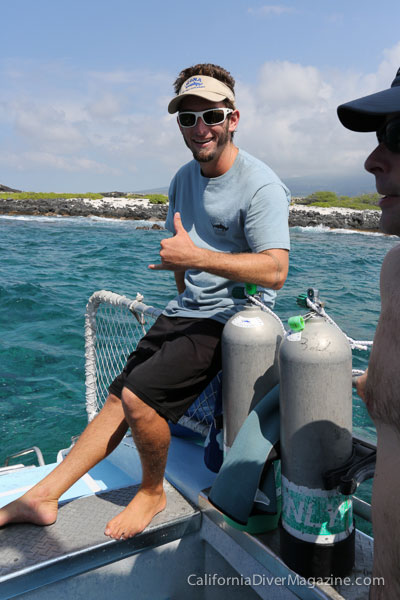
PADI Instructor and boat captain Tim “Shaggy” Mitchell
This structure and bottom profile here allow divers of all levels and abilities to share a dive trip, have completely different experiences, and dive different profiles at the same location. On the 2-tank trip I dove with them there were 2 student divers (Jeff, who was receiving his final certification dive, and his girlfriend Ingrid, who was earning her Advanced certification), another group of moderately experienced divers, and two visiting dive instructors (myself and editor Kevin Kay). Everyone on board had beautiful, enjoyable dives, and each dove within their training and comfort zones.
Many of us have had the experience of being hand-held along a dive at the pace of the least-common denominator. (I recall one experience I had in Cozumel where I burned through 20 minutes of air while virtually sitting in the sand under the dive boat at 30 feet, while the Divemaster assisted a new diver with buoyancy issues, then ear problems.) That’s an experience that simply won’t happen here.
“Our groups are based on experience and preferences. If someone is better on air, we’re not going to make them go up when a person who has a 45 minute dive is done. You get to dive your tank with us, which I think means a lot to people.”
Kerry continues, “Our dive guides will out breathe you. They are very, very few people that we’ve ever had where we’ve had to “call” their dive because one of us is out of air. That doesn’t happen here, because we’ll just pass you off (to another guide).
Kevin and I spent a beautiful Monday in late October diving with Kona Diving Company, which included two separate trips; 2 morning dives followed by an evening then night dive with the manta rays.
After a quick briefing at the start of a beautiful day, we boarded the Hale Kai at 7:45am and headed out of Honokohau Harbor. Kevin asked the routine question “where are we diving today?”, and their answer was as described earlier.
Our dive leader, Katie Key, asked “What kind of diving would you like to do?”. Kevin and I both agreed that we would like to dive in an area with some interesting structure, perhaps some lava tubes, arches, and swim-throughs. After a few more questions about what we would like to see, we set off to dive a site known as “Suck ‘em up”.
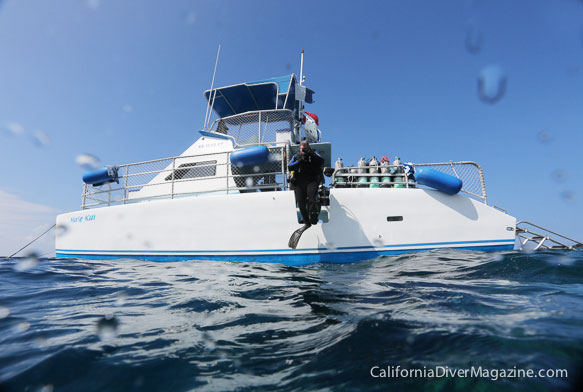
An easy entry off the Hale Kai into Hawaii’s warm, clear water
“The dive site is Suck ‘Em Up, named for a 40 foot lava tube that runs parallel to the shoreline in about 25 feet of water. There are various openings in the lava tube; entrances, exits, and a series of skylights. When it’s really surge-y it kind of does that plunger thing with divers, so that’s why it’s called “Suck ‘Em Up” – there are times when there’s kind of an unauthorized exit from one of those holes.” The depth here was quite shallow – less than 30 feet near shore – so it’s easy to see why this site could get rough when the weather rolls in.
Fortunately (or typically given that we’re in Hawaii), today was beautiful and the sea was very calm and friendly, making the dive more of a beautiful exploration vs. a carnival ride. We dove through arches, explored small caves, and…just to be safe…gave the shallow tubes near shore a bit of a safety margin.
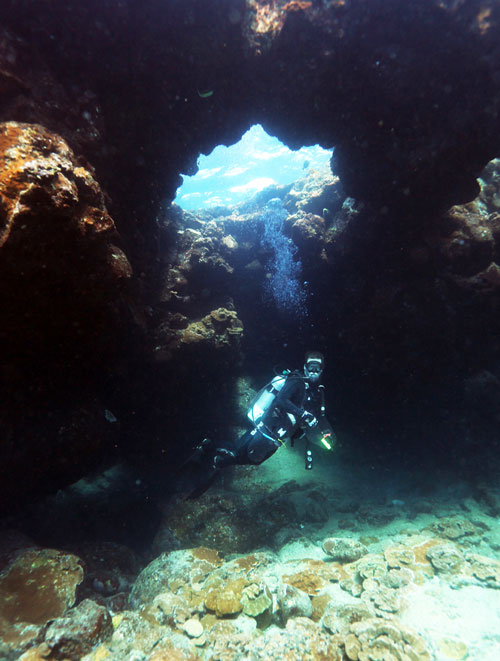
Beautiful structure and diving at our first dive location, which included “Suck ’em up” and Skull Cave.
Right next door to Suck ‘Em Up was Skull Cave. This is another kind of environment where you go in one way, swim around a little bit inside and leave through a different exit. There is beautiful light penetration in both areas today, with the help of direct sunlight through a cloudless sky. At one point we came across a small octopus, in addition to diving in an area rich with large beds of colorful corals and an abundance of yellow tangs, trumpetfish, butterflyfish, and a few small green moray eels.
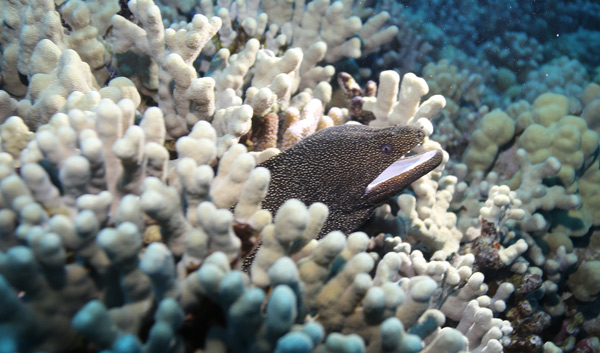
A speckled moray comes out to greet us.
Next we dove a location known as Eel Cove – so named for the huge population of fish here. The abundance of fish and beautiful topography combined with coral heads and boulders provided another beautiful site to explore in the 78-degree water. There we so many fish here that upon surfacing, I thought it might be a preserve area. Kerry explained, “No, it’s just naturally abundant. It’s just another area that’s kind of adjacent to a point, so there’s good nutrient in the water. All that coral coverage just feeds on that fishy kind of environment. That’s why we see all the layers of fish, from the little chromis above the coral heads to the bigger fish out hunting, and everything in between.
The friendly crew, in-between dive snacks, and wonderful dive conditions truly made this a great day on board the boat for all of the divers. After a few days of shore diving before, I quickly remembered how nice it is to have such service before and after the dives, assistance when donning and doffing the dive gear, rinsing off camera equipment, and the luxury of having your tanks changed for you between dives. Add the friendly crew, a beautiful day, and a container full of homemade brownies, and it truly is the best way to dive the Kona coast.
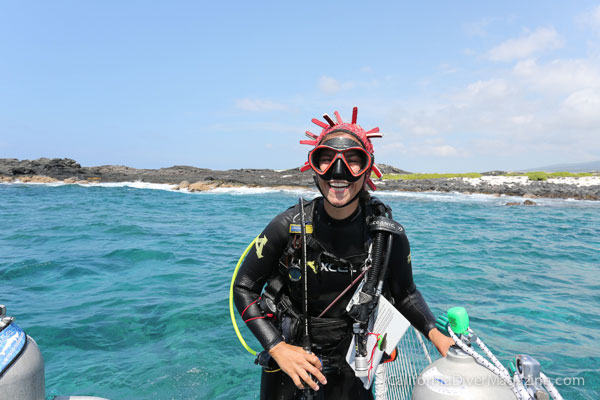
Everyone’s having fun aboard, including Katie Key who joined us for today’s dives
While heading back to the harbor, I rinsed off my camera equipment and chatted with the crew some more, and it was easy to see how excited the other divers were from their dives. There’s always a great vibe in the air when everyone is having a great time, and everybody on board felt it after these two dives. As great as they were, two dives weren’t really enough for Kevin and I – back at the harbor, we made a quick trip into town for lunch (passing up the beer, of course), then right back again for the night dive with the mantas.
If you haven’t done this dive (and even if you have), it’s a must-do when visiting Hawaii. The dive is shallow and suitable for all levels of divers; one diver in our group had just completed his final certification dive. PADI dive instructor, manta aficionado, and manta puppeteer Luke Mason provided a thorough (and entertaining) dive briefing, the crew marked everyone’s dive gear with illuminated markers, and everyone was provided a dive light for their dives. With an easy entry out of the gate and rendezvous at the anchor line, and we were off for a 45-minute dive with the mantas.
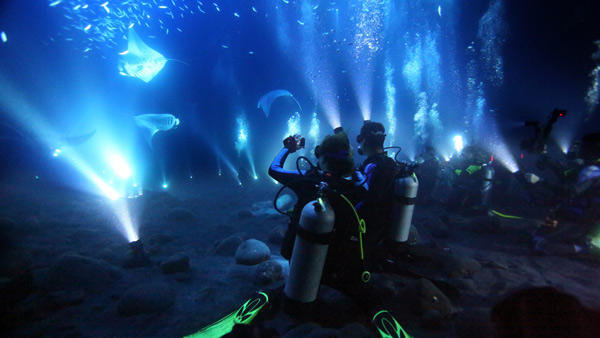
Yes, it’s really this cool. The night manta dive is a must-do while in Hawaii. Non-divers can snorkel it.
This manta dive takes place just offshore of the KOA airport in about 20 feet of water at a place called Garden Eel Cove. As the sun sets, dive boats move in and tie up to a buoy in the area, then just after dark, around 6:30pm, divers and snorkelers start to enter the water. Underwater, divers gather in a large circle at a sandy area on the bottom known as the “campfire”, which has a rock “fireplace” in the center. Divers are instructed to point their dive lights upwards to attract the plankton that mantas feed on, and the show begins.
The manta show ends when the divers return to the surface (the mantas would likely stay much longer if the lights stayed on). Thanks to the shallow depth and sitting idle for most of the dive, everyone has plenty of air and dive time to enjoy the experience.
Kevin and I did another day or two of shore dives, then dropped back into Kona Diving Company to return our rental tanks before flying home. We both agreed that this was an exceptional experience at every turn – from renting gear, asking about shore diving locations, scheduling and diving aboard their boat. Kona Diving Company has something you’ll rarely find in any retail or service business. It’s more than just providing great service and being friendly; there’s a vibe here where you’ll instantly feel welcomed and treated as family.
Stephany sums it up best: “We love what we do. There’s a reason that we’re in this – we don’t pick this so we could go diving every day. The kind of people who work here, they do this because they love getting other people stoked and have a great time. We just love what we do.”
- Colorful corals are abundant here
- Captain Mike Karlson
- Stephany, Katie, Hailey, and Ryan
- Air and nitrox. And just about everything else you’ll need
- KDC’s diver lounge area
- Katie Key having fun aboard the Hale Kai.
- A beautiful speckled moray comes out to greet us.
– – – – – –
Visit Kona Diving Company’s website at http://www.konadivingcompany.com
Read their independent reviews at TripAdvisor by clicking here (585 “excellent” reviews)
Story and photos by Chris Constantine and Kevin Kay, California Diver Magazine
All content ©2014 California Diver Magazine, and may not be copied, reposted, or reused without express written permission.

